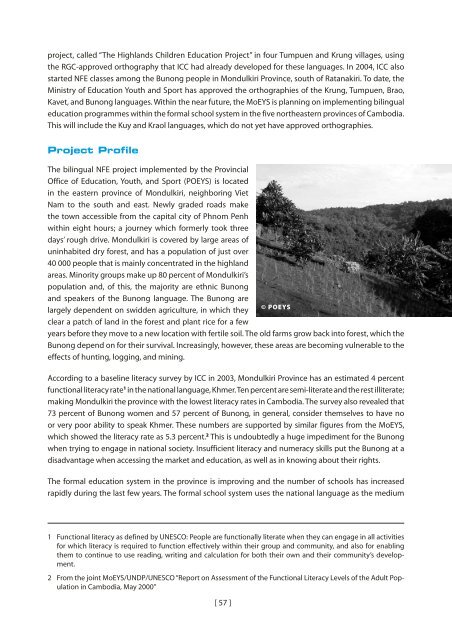Mother Tongue-based Literacy Programmes: Case Studies of Good ...
Mother Tongue-based Literacy Programmes: Case Studies of Good ...
Mother Tongue-based Literacy Programmes: Case Studies of Good ...
You also want an ePaper? Increase the reach of your titles
YUMPU automatically turns print PDFs into web optimized ePapers that Google loves.
project, called “The Highlands Children Education Project” in four Tumpuen and Krung villages, usingthe RGC-approved orthography that ICC had already developed for these languages. In 2004, ICC alsostarted NFE classes among the Bunong people in Mondulkiri Province, south <strong>of</strong> Ratanakiri. To date, theMinistry <strong>of</strong> Education Youth and Sport has approved the orthographies <strong>of</strong> the Krung, Tumpuen, Brao,Kavet, and Bunong languages. Within the near future, the MoEYS is planning on implementing bilingualeducation programmes within the formal school system in the five northeastern provinces <strong>of</strong> Cambodia.This will include the Kuy and Kraol languages, which do not yet have approved orthographies.Project Pr<strong>of</strong>ileThe bilingual NFE project implemented by the ProvincialOffice <strong>of</strong> Education, Youth, and Sport (POEYS) is locatedin the eastern province <strong>of</strong> Mondulkiri, neighboring VietNam to the south and east. Newly graded roads makethe town accessible from the capital city <strong>of</strong> Phnom Penhwithin eight hours; a journey which formerly took threedays’ rough drive. Mondulkiri is covered by large areas <strong>of</strong>uninhabited dry forest, and has a population <strong>of</strong> just over40 000 people that is mainly concentrated in the highlandareas. Minority groups make up 80 percent <strong>of</strong> Mondulkiri’spopulation and, <strong>of</strong> this, the majority are ethnic Bunongand speakers <strong>of</strong> the Bunong language. The Bunong are© POEYSlargely dependent on swidden agriculture, in which theyclear a patch <strong>of</strong> land in the forest and plant rice for a fewyears before they move to a new location with fertile soil. The old farms grow back into forest, which theBunong depend on for their survival. Increasingly, however, these areas are becoming vulnerable to theeffects <strong>of</strong> hunting, logging, and mining.According to a baseline literacy survey by ICC in 2003, Mondulkiri Province has an estimated 4 percentfunctional literacy rate 1 in the national language, Khmer. Ten percent are semi-literate and the rest illiterate;making Mondulkiri the province with the lowest literacy rates in Cambodia. The survey also revealed that73 percent <strong>of</strong> Bunong women and 57 percent <strong>of</strong> Bunong, in general, consider themselves to have noor very poor ability to speak Khmer. These numbers are supported by similar figures from the MoEYS,which showed the literacy rate as 5.3 percent. 2 This is undoubtedly a huge impediment for the Bunongwhen trying to engage in national society. Insufficient literacy and numeracy skills put the Bunong at adisadvantage when accessing the market and education, as well as in knowing about their rights.The formal education system in the province is improving and the number <strong>of</strong> schools has increasedrapidly during the last few years. The formal school system uses the national language as the medium1 Functional literacy as defined by UNESCO: People are functionally literate when they can engage in all activitiesfor which literacy is required to function effectively within their group and community, and also for enablingthem to continue to use reading, writing and calculation for both their own and their community’s development.2 From the joint MoEYS/UNDP/UNESCO “Report on Assessment <strong>of</strong> the Functional <strong>Literacy</strong> Levels <strong>of</strong> the Adult Populationin Cambodia, May 2000”[ 57 ]

















